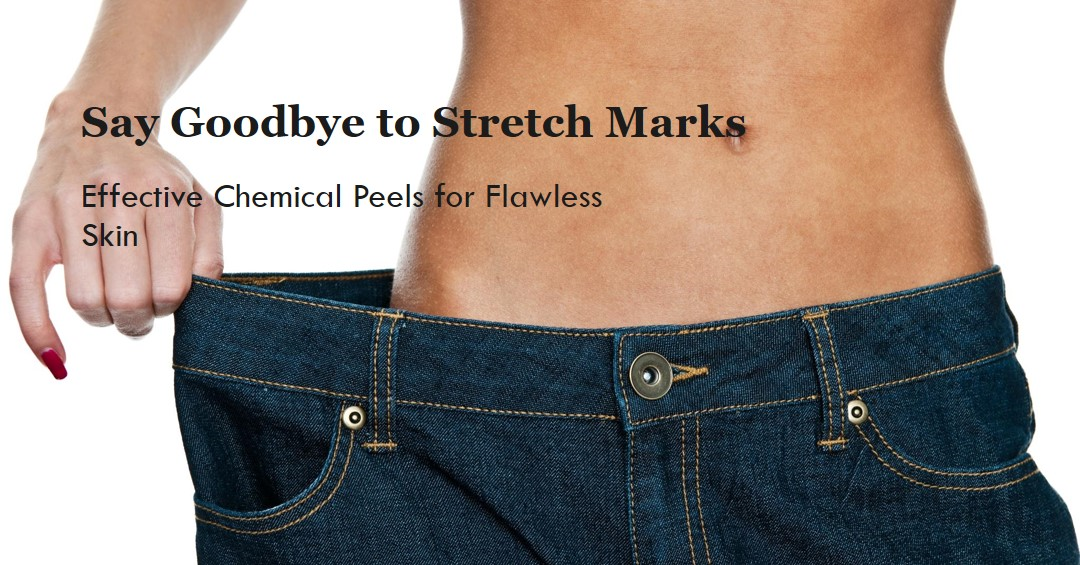Stretch marks, those distinct lines or streaks that appear on the skin, often come as a consequence of rapid stretching of the skin due to factors like pregnancy, significant weight gain or loss, and even growth spurts during puberty. For many, these marks are a cosmetic concern that can affect self-esteem and body image. However, advancements in dermatological treatments have made it possible to reduce their appearance significantly, with chemical peels emerging as a particularly effective option.
Understanding Stretch Marks
Before delving into the specifics of chemical peels, it’s important to understand what stretch marks are. Medically known as striae distensae, stretch marks occur when the skin’s connective tissue is stretched beyond the limits of its elasticity due to rapid expansion or contraction of the skin. When this happens, collagen and elastin, which support our skin, can rupture. As the skin heals, stretch marks may appear.
While stretch marks are typically red or purple at first, they tend to gradually fade to a lighter hue. The texture and color of these scars can make them notably different from the surrounding skin, making them more noticeable.
Chemical Peels: A Solution for Stretch Marks
Chemical peel for stretch marks, which have been used for decades to rejuvenate skin and improve complexion, can also be an effective treatment for reducing the appearance of stretch marks. A chemical peel involves applying a chemical solution to the skin, which causes the top layers to peel off. This process stimulates the production of new skin cells and collagen, potentially diminishing the visibility of stretch marks.
Types of Chemical Peels
- Superficial Peels: These peels use mild acids like alpha-hydroxy acid (AHA) to gently exfoliate the outer layer of skin. While beneficial for mild skin discoloration and rough texture, superficial peels are generally not effective for significant stretch mark reduction.
- Medium Peels: Utilizing trichloroacetic acid (TCA), medium peels penetrate the middle and outer layers of skin. They are more suitable for treating deeper pigment issues and minor skin surface anomalies, including lighter stretch marks.
- Deep Peels: The most intensive type of chemical peel, deep peels penetrate several layers of skin and can significantly improve the skin’s appearance. Phenol is commonly used in these peels and can dramatically reduce deeper stretch marks. However, deep peels require the most recovery time and carry greater risks.
Effectiveness and Research
Research suggests that medium to deep peels can be effective in reducing the appearance of stretch marks by promoting skin regeneration and collagen production. A study published in the Dermatologic Surgery journal found that a series of TCA peels effectively improved the appearance of stretch marks in over 70% of participants.
Considerations and Care
Chemical peels, especially medium and deep peels, should be performed by or under the supervision of a qualified dermatologist. It’s essential to consider the potential side effects, such as redness, swelling, and in rare cases, scarring. Post-treatment care is crucial and includes avoiding sun exposure and using prescribed skin care products.
Advancing Beyond Traditional Peels
In addition to the traditional superficial, medium, and deep peels discussed earlier, there are innovative approaches in the realm of chemical peels that enhance their effectiveness against stretch marks.
Combination Peels
Combination peels that blend different types of acids can target various layers of the skin simultaneously, offering a comprehensive approach to skin rejuvenation. For instance, a peel that combines glycolic acid with TCA can maximize skin turnover while minimizing the harshness typically associated with deeper peels. This method allows for a more controlled and gradual treatment of stretch marks, potentially enhancing outcomes with fewer side effects.
Pre-Treatment and Post-Treatment Care
Optimizing skin condition before and after a chemical peel is crucial for effectiveness and safety. Pre-treatment might involve using retinoid creams or other exfoliants to prepare the skin, making it more amenable to the chemical agents used in the peel. Post-treatment care is vital to prevent complications such as infections or hyperpigmentation. Proper hydration, use of recovery creams, and strict sun protection are essential steps to ensure a smooth recovery and optimal results.
Tailored Treatments for Different Skin Types
Skin type can significantly affect how an individual responds to chemical peels. Those with lighter skin tones might experience different results and side effects compared to individuals with darker skin. Dermatologists typically tailor the peel types, strengths, and care protocols to suit different skin tones and types, reducing potential risks and maximizing the benefits of the treatment.
Psychological Impact of Stretch Marks
The appearance of stretch marks can have a psychological impact, affecting self-esteem and body image. Many individuals seek treatment not just for aesthetic improvement but also for a psychological boost. Acknowledging this aspect, dermatological consultations often include discussions about expectations and emotional support, addressing both the physical and emotional aspects of skin treatments.
The Role of Diet and Lifestyle
While chemical peels can significantly improve the appearance of stretch marks, incorporating a healthy diet and lifestyle can support skin health and potentially enhance the results of treatments. Hydration, a balanced diet rich in vitamins and minerals, and avoiding smoking can improve skin elasticity and overall dermatological health, making the skin more resilient and responsive to treatments.
Latest Research and Innovations
Ongoing research continues to explore the limits and possibilities of chemical peels for skin rejuvenation. Innovations in peel formulations and techniques aim to provide safer, more effective solutions that can be customized to individual needs and conditions. Keeping abreast of the latest studies and breakthroughs can offer new avenues for those looking to minimize the appearance of stretch marks.
Stellar Health and Skin: Your Partner in Enhancing Beauty
We understand the importance of feeling confident in your skin. Our dermatological experts specialize in chemical peel for stretch marks tailored to reduce the appearance of stretch marks effectively. By choosing our services, you can expect a professional assessment and a treatment plan customized to your skin’s needs.
Frequently Asked Questions
Q1: How long does it take to see results from chemical peel for stretch marks? Results vary depending on the depth of the peel and the individual’s skin type, but many patients notice improvements within a few weeks after treatment.
Q2: Are chemical peels painful? Patients may experience a burning sensation during the treatment, but this is generally mild and short-lived.
Q3: How many treatments are needed to reduce stretch marks? It often requires multiple sessions to achieve significant results, especially for older or deeper stretch marks.
Q4: Can chemical peels remove stretch marks completely? While chemical peels can significantly reduce the appearance of stretch marks, they may not completely remove them.
Q5: Are there any long-term side effects of chemical peels? When performed correctly, long-term side effects are rare, but it’s important to discuss any potential risks with your dermatologist.
Conclusion
Chemical peels offer a promising solution for those looking to reduce the appearance of stretch marks and enhance their overall skin texture. With the right type of peel and proper care, you can achieve noticeable improvements in your skin’s appearance. At Stellar Health and Skin, we are committed to providing you with the care you need to feel more confident in your skin. Are you ready to rejuvenate your skin and reduce the visibility of your stretch marks?
Also know about Dermal Fillers for Lips: Enhance Volume & Shape






Leave A Comment